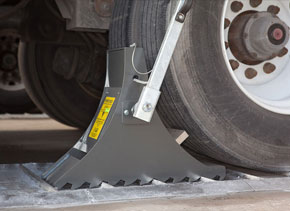 Safety is a key issue for many logistics-focused facilities. Injuries at the warehouse can bring operations to a grinding halt, which leads to reduced productivity. Worse yet are the fatalities that may occur during the loading or unloading of a semi-truck’s trailer. In fact, according to data cited by Industrial Safety & Hygiene News, “twenty five percent of all industrial accidents occur at the loading dock.”
Safety is a key issue for many logistics-focused facilities. Injuries at the warehouse can bring operations to a grinding halt, which leads to reduced productivity. Worse yet are the fatalities that may occur during the loading or unloading of a semi-truck’s trailer. In fact, according to data cited by Industrial Safety & Hygiene News, “twenty five percent of all industrial accidents occur at the loading dock.”
Because of this, many companies that specialize in handling logistics use a variety of safety tools to reduce the likelihood of on-the-job injuries at their loading docks. One example of a tool that can improve safety for your warehouse is the trailer restraint. These restraints commonly come in two forms:
- RIG-Dependent Restraints. Most truck trailers meant for road use have a rear impact guard (RIG) that is meant to keep cars that rear-end the trailer from sliding beneath it. RIG-dependent bar restraints use an adjustable barrier that holds the RIG in place to keep the trailer from shifting.
- Wheel Chocks. When the trailer doesn’t have a RIG to latch onto (or one that is somehow incompatible with your RIG-dependent restraint), the most common alternative is to use a set of wheel chocks to keep the trailer from shifting forwards or backwards.
It’s important to note that the RIG-dependent restraints can come in different styles ranging from automated restraints with programmable controls to manual restraints that use a push bar to latch onto the RIG.
So, How Do Trailer Restraints Improve Safety?
Trailer restraints play a key role in ensuring safety during loading dock operations. By locking the trailer in place, these restraints prevent the back-and-forth rocking motion that can occur during the loading or unloading of a trailer. Sometimes called “trailer creep,” this unexpected movement of the trailer can leave employees stepping onto open air, cause ramps to fall off while moving heavy pallets, or crush an employee’s leg(s) between the trailer and the loading dock.
Since trailer restraints stop the trailer from moving back and forth, the risk of injuries from trailer creep is significantly lessened. However, trailer restraints, like any safety system, are most effective when used as part of a consistent safety program.
Using Trailer Restraints to Maximize Safety at the Loading Dock
To maximize the safety benefit of trailer restraints, it’s important to have a consistent strategy for using them at your loading dock 100% of the time. Establish a policy that requires employees to not only use the restraint, but to double-check it and make sure it’s secure.
For example, if you have a RIG-dependent restraint with a status indicator, make employees log the status before beginning loading/unloading operations.
If the RIG-dependent restraint does not work, keep a set of wheel chocks handy. Because the goal is keep the trailer from moving backwards or forwards, use two wheel chocks—one on each side of the wheel. These chocks should sit on the center of the tire and be pushed in tightly—use of a rubber mallet or other hammer can be helpful here.
Only once the chocks are in place and secure should loading/unloading of the trailer begin.
Another strategy for maximizing safety is to use other protective measures around the loading dock in addition to your trailer restraints, including:
- Barrier lips to create a positive stop for forklifts.
- Bar lift barriers to keep forklifts from driving over the dock edge.
- Dock alert/communication systems to keep drivers from moving trailers at the wrong time.
- Dock lighting to keep work areas well-lit so dock operators can see what they’re doing.
- Safety gates to protect pedestrian walkways surrounding the loading dock area.
Each of these safety items (and your vehicle restraints) should be routinely inspected and given proper maintenance to ensure that they do not fail at a critical moment.
Need help finding top-quality vehicle restraints and other dock area safety equipment? Or, do you need service, parts, and support for your safety equipment? Perhaps you need some assistance in creating a safety program for your dock operations? Whatever your dock safety needs are, you can contact the experts at SSE to get help!






